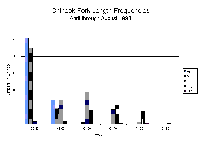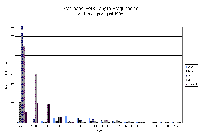| Area | Lower Trinity/Basin-wide |
| Topic | Fish: Horse Linto Cr Downstream Trap Results 1998 |
The length frequency of Chinook salmon by month in 1998 at the Horse Linto Creek trap is similar to results from 1996 but with some variation. (Note: X-axis should be labeled Fork Length in mm). The 1998 water year was extremely wet and high flows and cold water from snowmelt in the headwaters of Horse Linto likely delayed hatching and reduced the size of Chinook salmon relative to 1996. This contrast is even more clear with 1994, which was a very low flow year. The average length of Chinook juveniles in May 1998 was 25-40 mm (40-50 mm in May 1996 and 50-60 mm in May 1994). While Chinook juveniles in June 1994 were an average of 60-70 mm, fish did not obtain that size in 1998 until July. The largest migrant Chinooks captured in 1996 were 90 mm or less. The Lower Trinity Ranger District, Six Rivers National Forest, provided the graph above in an Excel spreadsheet. See Info Links for more information.
The graph above shows the size of juvenile steelhead by month at the Horse Linto Creek downstream migrant trap in 1998. (Note: the X-axis should be labeled Fork Length in mm). Older age steelhead showed an early migration peak as in prior samples with fish in this one to two year old age group continuing to be trapped into July. Few older age steelheads migrated after May in 1994, which was very dry. The high flows of 1998 were likely associated with cold stream temperatures, which in turn would make emergence of young of the year steelhead later, and their growth after emergence slower. This would be consistent with very small size of young of the year steelhead into June and July. Young of the year steelhead migrating in July 1994 fell more in the 50-60 mm range while the size of 1998 July migrants centered around 40 mm or less. Chart taken as image from Six Rivers National Forest Excel spreadsheet.
 Click on image to enlarge (12K).
Click on image to enlarge (12K). Click on image to enlarge (14K).
Click on image to enlarge (14K).
To learn more about this topic click Info Links
To view additional information (data source, aquisition date etc.) about this page, click Metadata
| www.krisweb.com |
